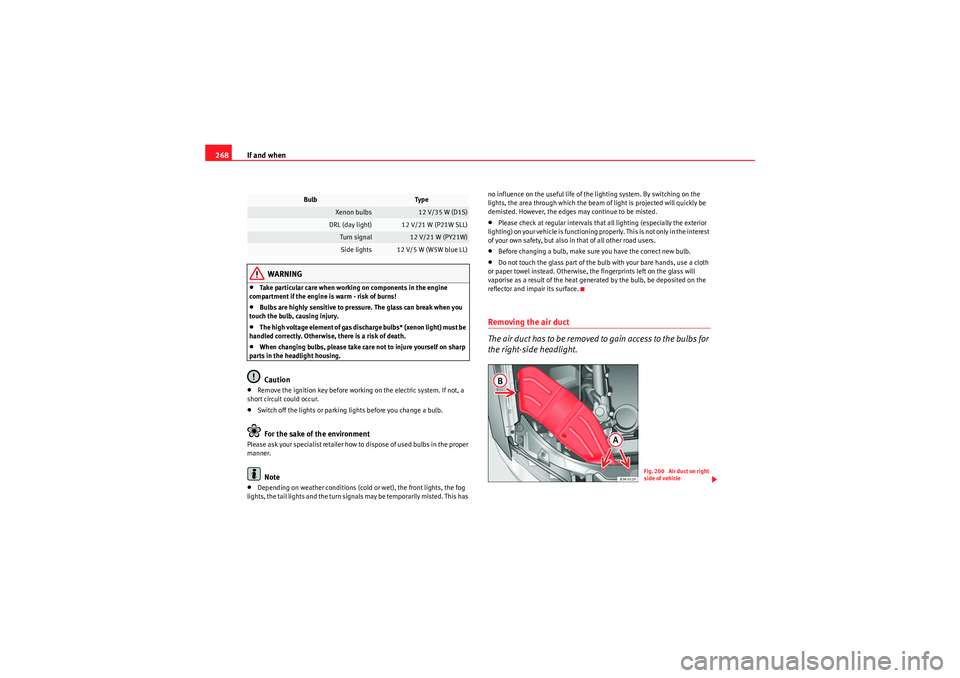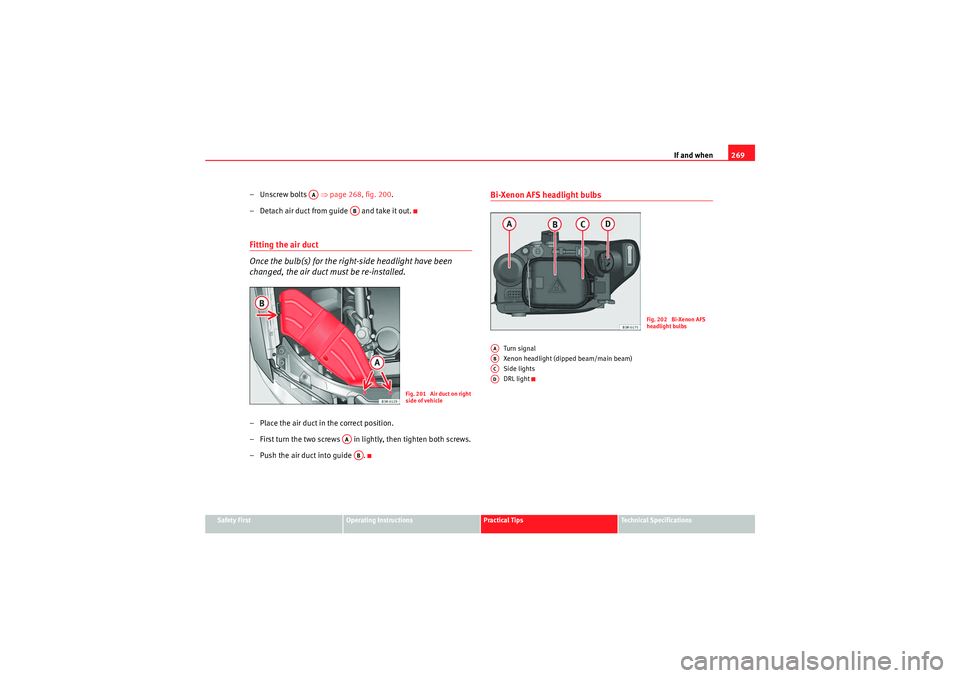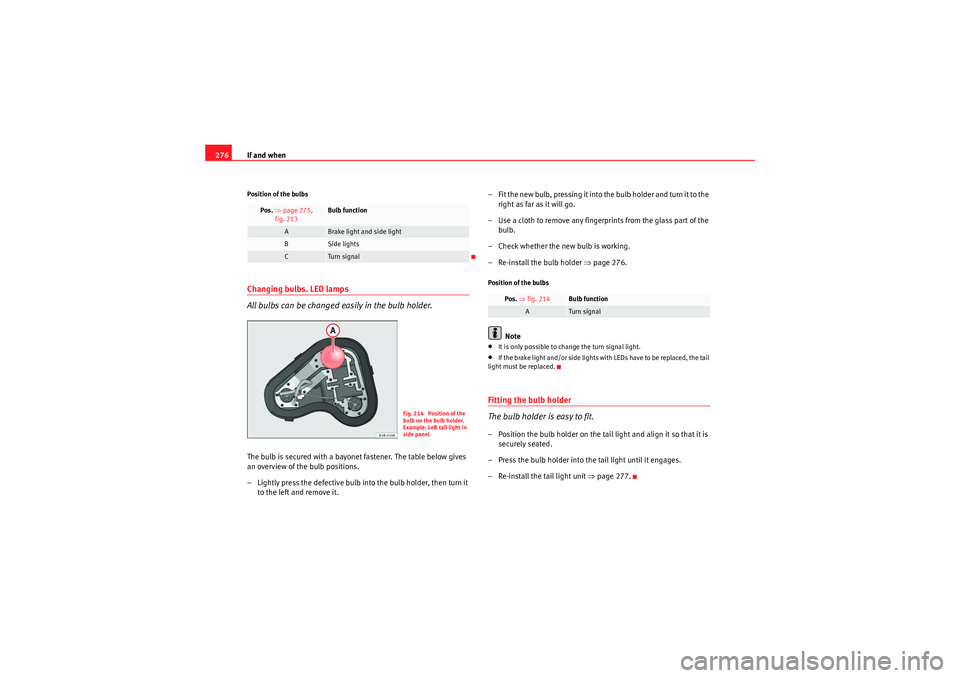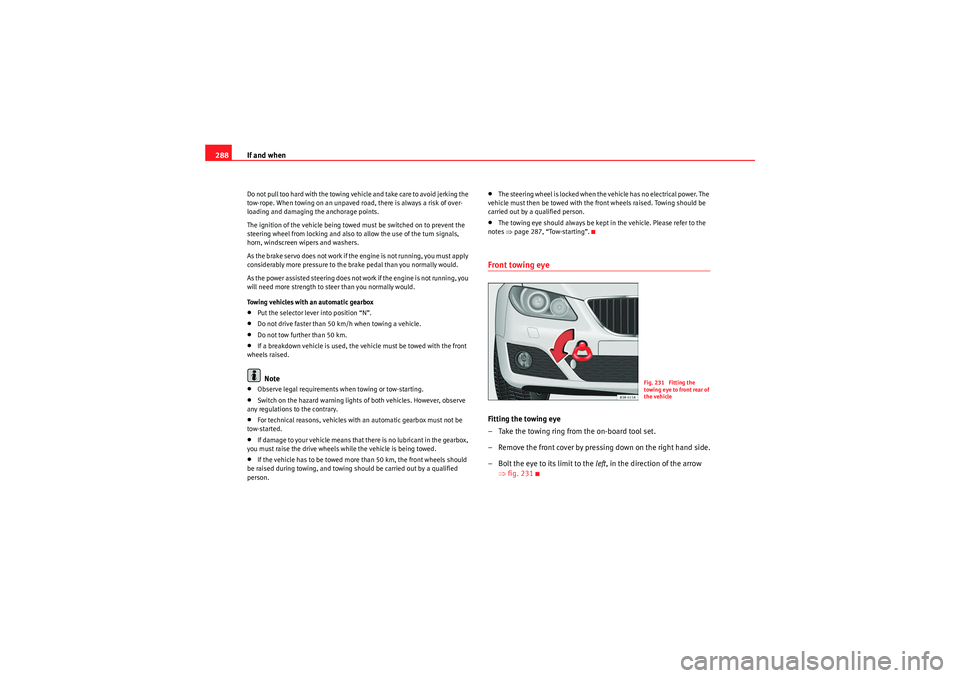turn signal Seat Exeo 2010 Owner's Guide
[x] Cancel search | Manufacturer: SEAT, Model Year: 2010, Model line: Exeo, Model: Seat Exeo 2010Pages: 319, PDF Size: 9.64 MB
Page 270 of 319

If and when
268
WARNING
•Take particular care when working on components in the engine
compartment if the engine is warm - risk of burns!•Bulbs are highly sensitive to pressure. The glass can break when you
touch the bulb, causing injury.•The high voltage element of gas discha rge bulbs* (xenon light) must be
handled correctly. Otherwise, there is a risk of death.•When changing bulbs, please take care not to injure yourself on sharp
parts in the headlight housing.Caution
•Remove the ignition key before working on the electric system. If not, a
short circuit could occur.•Switch off the lights or parking lights before you change a bulb.For the sake of the environment
Please ask your specialist retailer how to dispose of used bulbs in the proper
manner.
Note
•Depending on weather conditions (cold or wet), the front lights, the fog
lights, the tail lights and the turn signals may be temporarily misted. This has no influence on the useful life of the lighting system. By switching on the
lights, the area through which the beam of light is projected will quickly be
demisted. However, the edges may continue to be misted.
•Please check at regular intervals that all lighting (especially the exterior
lighting) on your vehicle is functioning properly. This is not only in the interest
of your own safety, but also in that of all other road users.•Before changing a bulb, make sure you have the correct new bulb.•Do not touch the glass part of the bulb with your bare hands, use a cloth
or paper towel instead. Otherwise, the fingerprints left on the glass will
vaporise as a result of the heat generated by the bulb, be deposited on the
reflector and impair its surface.Removing the air duct
The air duct has to be removed to gain access to the bulbs for
the right-side headlight.
Bulb
Type
Xenon bulbs
12 V/35 W (D1S)
DRL (day light)
12 V/21 W (P21W SLL)
Turn signal
12 V/21 W (PY21W)
Side lights
12 V/5 W (W5W blue LL)
Fig. 200 Air duct on right
side of vehicle
exeo_EN.book Seite 268 Montag, 30. August 2010 4:45 16
Page 271 of 319

If and when269
Safety First
Operating Instructions
Practical Tips
Technical Specifications
–Unscrew bolts ⇒ page 268, fig. 200.
– Detach air duct from guide and take it out.Fitting the air duct
Once the bulb(s) for the right-side headlight have been
changed, the air duct must be re-installed.– Place the air duct in the correct position.
– First turn the two screws in lightly, then tighten both screws.
– Push the air duct into guide .
Bi-Xenon AFS headlight bulbs
Turn signal
Xenon headlight (dipped beam/main beam)
Side lights
DRL light
AA
AB
Fig. 201 Air duct on right
side of vehicle
AAAB
Fig. 202 Bi-Xenon AFS
headlight bulbs
AAABACAD
exeo_EN.book Seite 269 Montag, 30. August 2010 4:45 16
Page 273 of 319

If and when271
Safety First
Operating Instructions
Practical Tips
Technical Specifications
Changing the turn signal bulb
The procedure for changing the bulb is the same on both
sides.
– Switch off the ignition and the lights.
– Raise the bonnet.
– Pull the rubber cap ⇒fig. 204 to remove it.
– Remove the bulb holder by pulling on the grip and turning it anti- clockwise ⇒fig. 205 .
– Replace the blown bulb in the bulb holder (press and turn anti- clockwise to remove) with a new bulb (press and turn clockwise
to insert).
– Insert the bulb holder into the socket with the tab facing upwards and the grip horizontal. Press it against the socket and turn
clockwise. When changing the bulb, you can check the position
of the bulb through the headlight glass.
– Fit the rubber cap and tighten, making sure it fit properly into the headlight casing.
– Check whether the new bulb is working.
Fig. 204 Turn signalFig. 205 Turn signal
exeo_EN.book Seite 271 Montag, 30. August 2010 4:45 16
Page 275 of 319

If and when273
Safety First
Operating Instructions
Practical Tips
Technical Specifications
Changing tail light bulbs (on side panel)Overview of tail lightsTail lights on side panel•Brake light and side light•Side lights•Turn signal
Overview of tail lights. LED lampsTail lights on side panel•Brake light and side light•Side lights•Turn signalNote
•It is only possible to change the turn signal light.•If the warning lamp for the brake light or side light (LED lamp) lights up,
the tail light assembly should be replaced.•The failure of the lamp is only shown when the LED function goes out
completely. Sometimes, a LED will stop working, without displaying the
warning as the function continues to operate.
Fig. 208 Overview of tail
lights
Fig. 209 Overview of tail
lights
exeo_EN.book Seite 273 Montag, 30. August 2010 4:45 16
Page 278 of 319

If and when
276Position of the bulbsChanging bulbs. LED lamps
All bulbs can be changed easily in the bulb holder.The bulb is secured with a bayonet fastener. The table below gives
an overview of the bulb positions.
– Lightly press the defective bulb into the bulb holder, then turn it
to the left and remove it. – Fit the new bulb, pressing it into the bulb holder and turn it to the
right as far as it will go.
– Use a cloth to remove any fingerp rints from the glass part of the
bulb.
– Check whether the new bulb is working.
– Re-install the bulb holder ⇒page 276.
Position of the bulbs
Note
•It is only possible to change the turn signal light.•If the brake light and/or side lights with LEDs have to be replaced, the tail
light must be replaced.Fitting the bulb holder
The bulb holder is easy to fit.– Position the bulb holder on the tail light and align it so that it is securely seated.
– Press the bulb holder into the tail light until it engages.
– Re-install the tail light unit ⇒page 277.
Pos. ⇒ page 275,
fig. 213
Bulb function
A
Brake light and side light
B
Side lights
C
Turn signal
Fig. 214 Position of the
bulb on the bulb holder.
Example: Left tail light in
side panel
Pos. ⇒ fig. 214
Bulb function
A
Turn signal
exeo_EN.book Seite 276 Montag, 30. August 2010 4:45 16
Page 283 of 319

If and when281
Safety First
Operating Instructions
Practical Tips
Technical Specifications
– Fit the new bulb, pressing it into the bulb holder and turn it to the
right as far as it will go.
– Use a cloth to remove any fingerp rints from the glass part of the
bulb.
– Check whether the new bulb is working.
– Re-install the bulb holder ⇒page 281.Position of the bulbsFitting the bulb holder
The bulb holder is easy to fit.– Check that the seal is seated correctly on the bulb holder.
– Position the bulb holder on the tail light and align it so that it is
securely seated.
– Press the bulb holder into the tail light until it engages.
– Fit the cover back in the inte rior trim so that it engages.
– Put the screwdriver back into the tool kit.
– Make sure that all bulbs for the tail lights are working.
Side turn signals– Press the turn signal to the left or to the right to remove the bulb.
– Remove the bulb holder from the turn signal.
– Remove the failed glass bulb and replace with a new bulb.
– Insert the bulb holder in the turn signal guide until it clicks into place.
– First place the turn signal in the opening in the bodywork, fixing the tabs ⇒ fig. 223, arrow .
– Insert the bulb as shown by the arrow ⇒fig. 223 .
Pos. ⇒ page 280,
fig. 222
Bulb function
A
Reverse light
Fig. 223 Side turn signal
A1
A2
exeo_EN.book Seite 281 Montag, 30. August 2010 4:45 16
Page 290 of 319

If and when
288Do not pull too hard with the towing vehicle and take care to avoid jerking the
tow-rope. When towing on an unpaved road, there is always a risk of over-
loading and damaging the anchorage points.
The ignition of the vehicle being towed must be switched on to prevent the
steering wheel from locking and also to allow the use of the turn signals,
horn, windscreen wipers and washers.
As the brake servo does not work if the engine is not running, you must apply
considerably more pressure to the brake pedal than you normally would.
As the power assisted steering does not work if the engine is not running, you
will need more strength to steer than you normally would.
Towing vehicles with an automatic gearbox•Put the selector lever into position “N”.•Do not drive faster than 50 km/h when towing a vehicle.•Do not tow further than 50 km.•If a breakdown vehicle is used, the vehicle must be towed with the front
wheels raised.Note
•Observe legal requirements when towing or tow-starting.•Switch on the hazard warning lights of both vehicles. However, observe
any regulations to the contrary.•For technical reasons, vehicles with an automatic gearbox must not be
tow-started.•If damage to your vehicle means that there is no lubricant in the gearbox,
you must raise the drive wheels while the vehicle is being towed.•If the vehicle has to be towed more than 50 km, the front wheels should
be raised during towing, and towing should be carried out by a qualified
person.
•The steering wheel is locked when the vehicle has no electrical power. The
vehicle must then be towed with the front wheels raised. Towing should be
carried out by a qualified person.•The towing eye should always be kept in the vehicle. Please refer to the
notes ⇒page 287, “Tow-starting”.Front towing eyeFitting the towing eye
– Take the towing ring from the on-board tool set.
– Remove the front cover by pressing down on the right hand side.
– Bolt the eye to its limit to the left, in the direction of the arrow
⇒ fig. 231
Fig. 231 Fitting the
towing eye to front rear of
the vehicle
exeo_EN.book Seite 288 Montag, 30. August 2010 4:45 16
Page 316 of 319

Index
314Steering
Locking . . . . . . . . . . . . . . . . . . . . . . . . . . . . 167
Manual steering wheel adjustment . . . . . . 166
Steering wheel controls . . . . . . . . . . . . . . . . . . . 91
Stopping the engine . . . . . . . . . . . . . . . . . . . . . 169
Sun visors . . . . . . . . . . . . . . . . . . . . . . . . . . . . . 126
Switches in the driver door Electric windows . . . . . . . . . . . . . . . . . . . . . 109
Symbols Red symbols in central display . . . . . . . . . . 77
Yellow symbols in central display . . . . . . . . 79TTailgateCentral locking system . . . . . . . . . . . . . . . . 103
Light . . . . . . . . . . . . . . . . . . . . . . . . . . . . . . . 125
TCS How the system works . . . . . . . . . . . . . . . . 188
Technical modifications . . . . . . . . . . . . . . . . . . 218
The danger of not using the seat belt . . . . . . . . 20
The environment Heated rear window . . . . . . . . . . . . . . . . . . 126
Leaks . . . . . . . . . . . . . . . . . . . . . . . . . . . . . . 224
Warming up the engine . . . . . . . . . . . . . . . 168
Tightening torque of wheel bolts . . . . . . . . . . . 294
tiptronic . . . . . . . . . . . . . . . . . . . . . . . . . . . 177, 183
Tools . . . . . . . . . . . . . . . . . . . . . . . . . . . . . . . . . . 247
Tow starting General notes . . . . . . . . . . . . . . . . . . . . . . . 287 Towing . . . . . . . . . . . . . . . . . . . . . . . . . . . . 198, 287
Accessories . . . . . . . . . . . . . . . . . . . . . . . . . 200
Notes on towing . . . . . . . . . . . . . . . . . 198, 199
Removable towing bracket . . . . . . . . . . . . . 201
Technical requirements . . . . . . . . . . . . . . . 198
Towing a trailer . . . . . . . . . . . . . . . . . . . . . . . . . 293
Towing bracket, fitting . . . . . . . . . . . . . . . . . . . 207
Towing eye . . . . . . . . . . . . . . . . . . . . . . . . . . . . . 287
Towing eyes . . . . . . . . . . . . . . . . . . . . . . . . . . . . 288
Tow-starting . . . . . . . . . . . . . . . . . . . . . . . . . . . . 287
Traction control system How the system works . . . . . . . . . . . . . . . . 188
Trailer weights . . . . . . . . . . . . . . . . . . . . . . . . . . 293
Trip recorder . . . . . . . . . . . . . . . . . . . . . . . . . . . . 63
Turn signal lamps Hazard warning lights . . . . . . . . . . . . . . . . . . 68
Trailer turn signals . . . . . . . . . . . . . . . . . . . . 67
Turn signals . . . . . . . . . . . . . . . . . . . . . . . . . . 68
Turn signals . . . . . . . . . . . . . . . . . . . . . . . . . . . . 122
Tyre Mobility System . . . . . . . . . . . . . . . . . . . . . 254
Tyre mobility system . . . . . . . . . . . . . . . . . . . . . 248
Tyre pressure . . . . . . . . . . . . . . . . . . . . . 66, 90, 238 Loss . . . . . . . . . . . . . . . . . . . . . . . . . . . . . . . 240
Tyre pressure monitoring . . . . . . . . . . . . . . . . . 239
Tyre pressure monitoring system . . . . . . . . . . . . 89
Tyre pressures . . . . . . . . . . . . . . . . . . . . . . . . . . 294
Tyre repair kit Tyre Mobility System . . . . . . . . . . . . . . . . . . 254
Tyres and wheels Dimensions . . . . . . . . . . . . . . . . . . . . . . . . . 244 Tyres service life . . . . . . . . . . . . . . . . . . . . . . . . 241
Tyres tread depth . . . . . . . . . . . . . . . . . . . . . . . 242
Tyres with directional tread pattern . . . . . . . . . 238
UUnderbody protection . . . . . . . . . . . . . . . . . . . . 214VVehicle data . . . . . . . . . . . . . . . . . . . . . . . . . . . . 292
Vehicle identification data . . . . . . . . . . . . . . . . 292
Vehicle identification number . . . . . . . . . . . . . 292
Vehicle keys . . . . . . . . . . . . . . . . . . . . . . . . . . . . 96
Vehicle Maintenance
Exterior . . . . . . . . . . . . . . . . . . . . . . . . . . . . . 210
Vehicle modifications . . . . . . . . . . . . . . . . . . . . 218
Vehicle paintwork Maintenance . . . . . . . . . . . . . . . . . . . . . . . . 211
Products for vehicle maintenance . . . . . . . 209
Vehicle washing . . . . . . . . . . . . . . . . . . . . . . . . 210
Ventilation slits . . . . . . . . . . . . . . . . . . . . . . . . . . 17WWarning lamp . . . . . . . . . . . . . . . . . . . . . . . . . . . 29 Alternator . . . . . . . . . . . . . . . . . . . . . . . . . . . . 69
Warning lamps Airbag . . . . . . . . . . . . . . . . . . . . . . . . . . . . . . 66
Anti-lock brake system . . . . . . . . . . . . . . . . . 67
Electronic differential lock . . . . . . . . . . . . . . 67
exeo_EN.book Seite 314 Montag, 30. August 2010 4:45 16